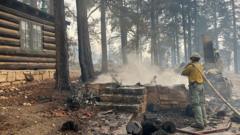The Grand Canyon, a popular tourist destination, has faced unprecedented fire damage, prompting the closure of the North Rim for the rest of the season.
The historic Grand Canyon Lodge, an essential part of the park's heritage since the 1930s, tragically fell victim to the Dragon Bravo Fire, one of two raging blazes in the area. This fire, known to have started on July 4th from a lightning strike, and the subsequent White Sage Fire, which ignited on July 9th, have combined to threaten thousands of acres and numerous buildings. Reports indicate that they are currently uncontained, leading to significant evacuations and forced closures, particularly affecting the North Rim’s tourist operations.
The Lodge itself was not only an accommodation but also housed dining facilities, a gift shop, and a post office, serving visitors exploring the park's wonders. Aramark, the lodge’s operating company, expressed deep sorrow over the loss while confirming that all staff and guests were safely evacuated without any injuries reported. The National Park Service estimates that between 50 to 80 structures, including administrative and visitor buildings, have suffered extensive damage.
In addition to the fire threat, conditions have been worsened by high winds reaching up to 40 mph, complicating firefighting efforts and prompting emergency evacuations due to the discovery of chlorine gas leaks from a water treatment facility nearby.
Arizona Governor Katie Hobbs has called for an investigation into how the federal government managed the initial Dragon Bravo Fire, suggesting there was a failure in oversight. The US Interior Department refuted claims of mismanagement, citing their serious approach to wildfire threats. Meanwhile, the second fire, the White Sage Fire, continues to expand, burning over 40,000 acres of the Kaibab National Forest and displacing hundreds of residents. In light of these events, the Grand Canyon remains a prime tourism spot, with the South Rim still accessible to visitors.
The historic Grand Canyon Lodge, an essential part of the park's heritage since the 1930s, tragically fell victim to the Dragon Bravo Fire, one of two raging blazes in the area. This fire, known to have started on July 4th from a lightning strike, and the subsequent White Sage Fire, which ignited on July 9th, have combined to threaten thousands of acres and numerous buildings. Reports indicate that they are currently uncontained, leading to significant evacuations and forced closures, particularly affecting the North Rim’s tourist operations.
The Lodge itself was not only an accommodation but also housed dining facilities, a gift shop, and a post office, serving visitors exploring the park's wonders. Aramark, the lodge’s operating company, expressed deep sorrow over the loss while confirming that all staff and guests were safely evacuated without any injuries reported. The National Park Service estimates that between 50 to 80 structures, including administrative and visitor buildings, have suffered extensive damage.
In addition to the fire threat, conditions have been worsened by high winds reaching up to 40 mph, complicating firefighting efforts and prompting emergency evacuations due to the discovery of chlorine gas leaks from a water treatment facility nearby.
Arizona Governor Katie Hobbs has called for an investigation into how the federal government managed the initial Dragon Bravo Fire, suggesting there was a failure in oversight. The US Interior Department refuted claims of mismanagement, citing their serious approach to wildfire threats. Meanwhile, the second fire, the White Sage Fire, continues to expand, burning over 40,000 acres of the Kaibab National Forest and displacing hundreds of residents. In light of these events, the Grand Canyon remains a prime tourism spot, with the South Rim still accessible to visitors.























